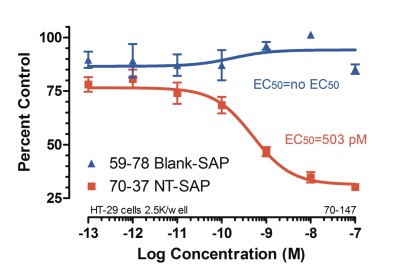Neurotensin is a 13 amino acid peptide found in the brain and spinal cord (first characterized by Carraway and Leeman1). It affects pituitary hormone release, interacts with the dopaminergic system, and is involved in vasodilation and hypotension. It can also modulate pain perception.
Advanced Targeting Systems is pleased to announce two conjugates that will be valuable tools for researchers. Neurotensin- SAP (Cat. #IT-56) is a chemical conjugate of neurotensin and the ribosome-inactivating protein, saporin. Neurotensin-SAP will specifically eliminate cells that express neurotensin receptors. Neurotensin-CTA (Cat. #IT-60) is a chemical conjugate of neurotensin and the catalytic A subunit of cholera toxin. Neurotensin-CTA will specifically stimulate cells expressing neurotensin receptors.
To Terminate or Stimulate? That is the question. . . Here are the tools!
IT-56 Neurotensin-SAP
available individually or in a kit with saporin (Cat. #PR-01) and Blank-SAP (Cat. #IT-21)
IT-60 Neurotensin-CTA
available individually or in a kit with Blank-CTA (Cat. #IT-61)
When either of these targeted conjugates are administered to cells (in vitro or in vivo), the targeting agent seeks out and binds only to cells expressing neurotensin receptors. The conjugate is internalized.
To Terminate: When using Neurotensin-SAP, saporin breaks away from the targeting agent, and inactivates the ribosomes which causes protein synthesis inhibition and, ultimately, cell death. Cells which do not have the cell surface marker are not affected.
To Stimulate: When using Neurotensin-CTA, the catalytic A subunit of cholera toxin (CTA) breaks away from the targeting agent, and activates the cAMP pathway within the cells by ribosylating adenylate cyclase. Cells which do not have the cell surface marker are not affected.
Reference
1. Carraway R, Leeman S. The isolation of a new hypotensive peptide, neurotensin, from bovine hypothalami. J Biol Chem 1973;248(19):6854-6861.

